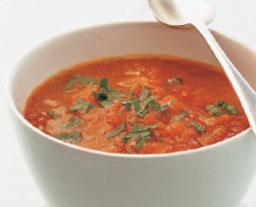Kosher and Traditional Jewish Cooking: Authentic Recipes From a Classic Culinary Heritage: 130 Delicious Dishes Shown in 220 Stunning Photographs (48 page)
Authors: Marlena Spieler
PURIM
Festival celebrating the rescue of the Jewish people from Haman, as described in the Book of Esther.
RAS AL HANOUT
A Moroccan spice mixture that literally means head of the shop. Ras al hanout can contain myriad ingredients, and each spice shop guards its own secret recipe.
ROSH HASHANAH
The Jewish New Year, literally meaning head of the year.
RUGELACH
Crisp, Ashkenazi cinnamon-and-sugar layered biscuits (cookies).
RYE BREAD
A typical bread from Eastern Europe, especially the Ukraine, where it is made with sourdough studded with caraway seeds. It is often baked on a cornmeal-coated baking sheet and is, therefore, sometimes known as corn rye.
SALT HERRING
Herring preserved in wooden barrels in layers of salt.
SAUERKRAUT
Fermented, pickled cabbage, made by salting shredded cabbage. It is a staple of the people of Eastern and parts of Western Europe.
SCHAV
A refreshing, sour green soup made from sorrel and eaten cold. It is a traditional Ashkenazi soup and can be bought in bottles in American delis.
SCHMALTZ
Yiddish for fat, usually referring to rendered chicken fat.
SCHMALTZ HERRING
See salt herring.
SCHNITZEL
Tender escalopes (US scallops) of meat or poultry, coated in crumbs and fried. They originate from Vienna.
SEDER
The ceremonial dinner eaten on the eve of Pesach, commemorating the flight of the Jews from Egypt.


SEPHARDIM
Jews who settled in Iberia (Spain and Portugal), after the destruction of the Second Temple, when they were banished from Jerusalem.
SHABBAT
Religious day of rest, which is a Saturday.
SHALACH MANOT
Food given at Purim.
SHALET
Baked Ashkenazi dessert of apple and eggs, favoured by the Jews of Alsace. Other ingredients such as matzo, challah, dried fruit and spices may be added.
SHAVUOT
Feast of the weeks, commemorating the revelation of the Ten Commandments.
SHOCHET
The ritual butcher, licensed to slaughter and prepare meat according the laws of Kashrut.
SHTETL
Yiddish for the Jewish villages of Eastern Europe.
SHULCHAN ARUKH
A code of Jewish law.
SIMCHAT TORAH
The festival of the Torah, celebrated by parading the Torah through the synagogue.
SOUR SALT
Citric acid, a souring agent used in Russia and in traditional Jewish cooking. It is available in crystals or grains.
SPAETZEL
Tiny dumplings made of noodle dough, dripped into boiling water. Also known as farfel.
STRUDEL
Eastern European speciality of crisp, layered pastry filled with fruit, sprinkled with sugar and served as a mid-afternoon treat with tea. Strudel can also be savoury, filled with vegetables, meat and sometimes fish.
SUFGANIOT
Israeli jam-filled doughnuts, eaten to celebrate Chanukkah.
SUKKOT
The autumn harvest festival, the celebration of which includes eating meals in gaily decorated three-walled huts known as sukkah.
SUMAC/SUMAK
A sour-tasting, red spice made from ground berries of the sumac plant. Israelis, and some Sephardim, sprinkle the spice over salads, breads and rice.
TAHINA/TAHINI
A Middle Eastern paste of toasted hulled sesame seeds, mixed with lemon juice, garlic and spices, and thinned with water. It is eaten as a sauce, dip, or ingredient in dishes such as hummus.
TEIGLACH
Ashkenazi cookies that have been cooked in honey. They are a Lithuanian speciality, which are popular in communities that celebrate their Lithuanian origins, such as South Africa. They are favoured at Rosh Hashanah when sweet foods are eaten in hope of a sweet new year.
TORAH
The scroll used in the synagogue, consisting of the first five books of the Bible, which include the Ten Commandments. The Torah was given to the Jews by God on Mount Sinai.
TORSHI
Pickled vegetables, eaten throughout the Middle East, especially Persia.
TREYF
Meaning not kosher. Also known as tref and trefah.
TU B’SHEVAT
Festival known as the birthday of the trees.
TZIMMES
A sweet dish of carrots, vegetables, dried fruit and sweetening agent such as honey or sugar. Spices, and sometimes meat, are added.
VARENIKES
Ashkenazi fruit-filled pasta dumplings filled with dried apricots, cherries or prunes.
VARNISHKES
Noodles shaped like bow ties or butterflies, often served with kasha.
WARKA
Very thin, transparent pastry from Morocco.
WAT/WOT
Spicy Ethiopian stew, enjoyed by the Bene Israel (Ethiopian Jews). It is often eaten for Shabbat.
YOM KIPPUR
The Day of Atonement, a solemn holy day upon which fasting is strictly observed.
ZAHTAR/ZA’ATAR
This is both the name of the wild herbs that grow in the hillsides of Israel and the Middle East, and the name of the spice mixture made with them, which includes zahtar, ground cumin, toasted sesame seeds, coriander seeds and sometimes a little sumac and/or crushed toasted hazelnuts. Zahtar is eaten for breakfast, as a dip with fresh pitta bread, a drizzle of olive oil and fresh goat’s cheese.
ZCHUG/ZHUG/ZHOUG
This Yemenite seasoning paste is one of Israel’s most popular spice mixtures. It may be red, based on chillies, garlic, spices, coriander (cilantro) and parsley, or green, with more herbs and less or no tomatoes.
ZEROA
A lamb’s bone, often a shank, roasted and placed on the ritual plate for Pesach. It represents the sacrificial lambs eaten on the eve of the flight of the Jews from Eygpt.

A
almonds
apples
apricots
artichokes
aubergines
B
beetroot
fragrant beetroot and vegetable soup with spiced lamb kubbeh
C